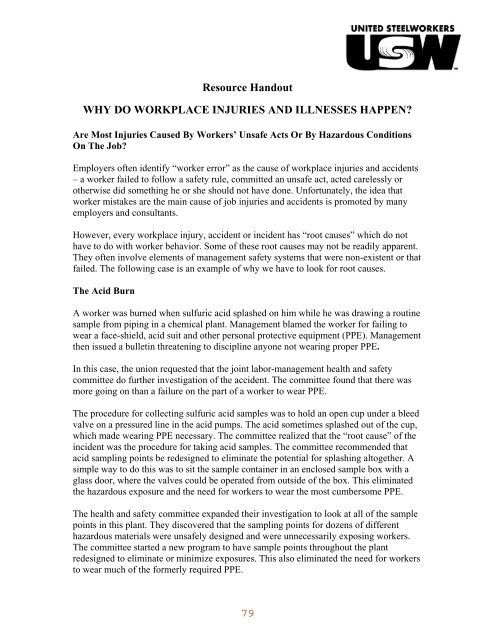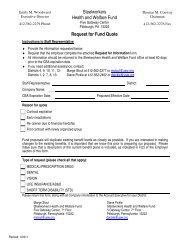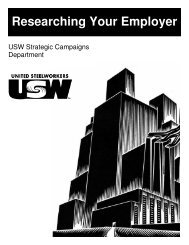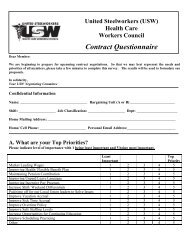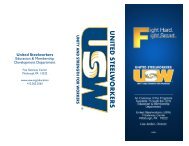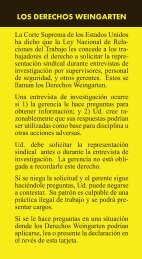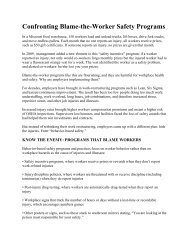Union Approach to Health and Safety: - United Steelworkers
Union Approach to Health and Safety: - United Steelworkers
Union Approach to Health and Safety: - United Steelworkers
You also want an ePaper? Increase the reach of your titles
YUMPU automatically turns print PDFs into web optimized ePapers that Google loves.
Resource H<strong>and</strong>out<br />
WHY DO WORKPLACE INJURIES AND ILLNESSES HAPPEN?<br />
Are Most Injuries Caused By Workers’ Unsafe Acts Or By Hazardous Conditions<br />
On The Job?<br />
Employers often identify “worker error” as the cause of workplace injuries <strong>and</strong> accidents<br />
– a worker failed <strong>to</strong> follow a safety rule, committed an unsafe act, acted carelessly or<br />
otherwise did something he or she should not have done. Unfortunately, the idea that<br />
worker mistakes are the main cause of job injuries <strong>and</strong> accidents is promoted by many<br />
employers <strong>and</strong> consultants.<br />
However, every workplace injury, accident or incident has “root causes” which do not<br />
have <strong>to</strong> do with worker behavior. Some of these root causes may not be readily apparent.<br />
They often involve elements of management safety systems that were non-existent or that<br />
failed. The following case is an example of why we have <strong>to</strong> look for root causes.<br />
The Acid Burn<br />
A worker was burned when sulfuric acid splashed on him while he was drawing a routine<br />
sample from piping in a chemical plant. Management blamed the worker for failing <strong>to</strong><br />
wear a face-shield, acid suit <strong>and</strong> other personal protective equipment (PPE). Management<br />
then issued a bulletin threatening <strong>to</strong> discipline anyone not wearing proper PPE.<br />
In this case, the union requested that the joint labor-management health <strong>and</strong> safety<br />
committee do further investigation of the accident. The committee found that there was<br />
more going on than a failure on the part of a worker <strong>to</strong> wear PPE.<br />
The procedure for collecting sulfuric acid samples was <strong>to</strong> hold an open cup under a bleed<br />
valve on a pressured line in the acid pumps. The acid sometimes splashed out of the cup,<br />
which made wearing PPE necessary. The committee realized that the “root cause” of the<br />
incident was the procedure for taking acid samples. The committee recommended that<br />
acid sampling points be redesigned <strong>to</strong> eliminate the potential for splashing al<strong>to</strong>gether. A<br />
simple way <strong>to</strong> do this was <strong>to</strong> sit the sample container in an enclosed sample box with a<br />
glass door, where the valves could be operated from outside of the box. This eliminated<br />
the hazardous exposure <strong>and</strong> the need for workers <strong>to</strong> wear the most cumbersome PPE.<br />
The health <strong>and</strong> safety committee exp<strong>and</strong>ed their investigation <strong>to</strong> look at all of the sample<br />
points in this plant. They discovered that the sampling points for dozens of different<br />
hazardous materials were unsafely designed <strong>and</strong> were unnecessarily exposing workers.<br />
The committee started a new program <strong>to</strong> have sample points throughout the plant<br />
redesigned <strong>to</strong> eliminate or minimize exposures. This also eliminated the need for workers<br />
<strong>to</strong> wear much of the formerly required PPE.


